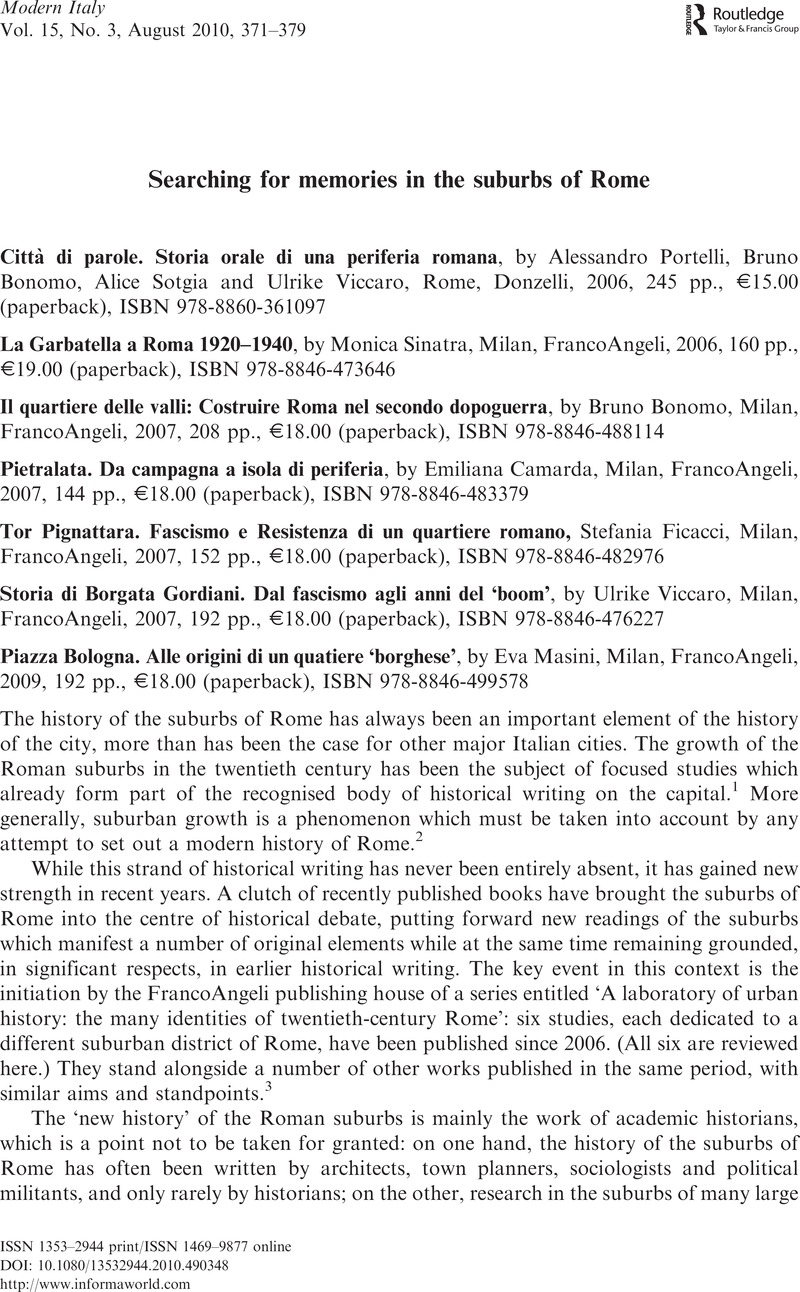No CrossRef data available.
Published online by Cambridge University Press: 05 February 2016

1. Berlinguer, Giovanni, and Seta, Piero Della. 1960. Borgate di Roma. Roma: Editori Riuniti; Ferrarotti. Franco Roma da capitale a periferia . Bari, : Laterza, 1970; Bortolotti, Lando. 1988. Roma fuori le mura. Rome–Bari: Laterza.Google Scholar
2. Insolera, Italo. 1962 (new edition, ibid. 1993). Roma moderna. Torino: Einaudi; Seronde Babonaux, Anne-Marie. 1980. De l'urbs à la ville. Rome: croissance d'une capitale. Aixen-Provence: Edisud. Translated as Roma: dalla città alla metropoli. Rome: Editori Riuniti, 1983; Bartolini, Francesco. 2008. Roma dall'Unità a oggi. Rome: Carocci.Google Scholar
3. Severino, Carmelo G. 2005. Roma, mosaico urbano: il Pigneto fuori Porta Maggiore. Rome: Gangemi; Sirleto, Francesco. 2006. Quadraro: una storia esemplare. Le vite e le lotte dei lavoratori edili di un quartiere periferico romano. Rome: Ediesse/Fondazione Giuseppe Di Vittorio.Google Scholar
4. Portelli, , Alessandro. 1999. L'ordine è già stato eseguito: Roma, le Fosse Ardeatine, la memoria. Rome: Donzelli.Google Scholar
5. Vidotto, Vittorio. 2001 (2nd ed. 2006). Roma contemporanea. Rome–Bari: Laterza.Google Scholar
6. Portelli, , L'ordine è già stato eseguito cit., pp. 12, 10.Google Scholar
7. The targets of Vidotto's polemic were primarily the works of Italo Insolera and Antonio Cederna: see Insolera, , Roma moderna, cit.; and Cederna, Antonio. 1965. Mirabilia urbis: Cronache romane 1957–1965. Torino: Einaudi.Google Scholar
8. Vidotto, , Roma contemporanea, cit., p. 289.Google Scholar
9. Portelli, , 2006. The work on Centocelle was preceded by a project carried out by the Circolo Gianni Bosio on the Borgo ragazzi di Don Bosco (‘Don Bosco Boys’ Town’) created by the Salesian order in the post-war period. See Portelli, Alessandro, ed. 2002. Il borgo e la borgata. I ragazzi di Don Bosco e l'altra Roma del dopoguerra. Rome: Donzelli.Google Scholar
10. Bartolini, Francesco. 2001. Roma borghese. La casa e i ceti medi tra le due guerre. Rome–Bari: Laterza; Vidotto, Vittorio, ed. Contributi allo studio delle trasformazioni urbane e della proprietà immobiliare a Roma dopo il 1870. Special issue of Dimensioni e problemi della ricerca storica 1 (2005); Salsano, Fernando. 2007. Il ventre di Roma. Trasformazione monumentale dell'area dei fori e nascita delle borgate negli anni del Governatorato fascista. Doctoral thesis in Social and Political History of Modern and Contemporary Europe, Università di Tor Vergata, XIX ciclo, Rome; id. 2008. Il Governatorato di Roma e l'Istituto case popolari. Gli sventramenti nell'area dei Fori imperiali. Le carte e la storia 2: 172–86.Google Scholar
11. Piccioni, Lidia. 1984. San Lorenzo, un quartiere romano durante il fascismo. Rome: Edizioni di Storia e Letteratura.Google Scholar
12. Although Stefania Ficacci's book on Tor Pignattara includes an appendix dedicated to ‘sources of memory’, the information provided does not make it possible to quantify the number of interviews conducted by the author, although the number would appear to be limited.Google Scholar
13. The areas also feature in films such as L'onorevole Angelina by Zampa, Luigi (1947) and in Elsa Morante's novel La storia (1974).Google Scholar
14. Braghin, Paolo ed. 1978. Inchiesta sulla miseria in Italia (1951–52). Turin: Einaudi.Google Scholar
15. See for example Di Biagi, Paola Elena Marchigiani, Marin, Alessandra. 2002. Trieste '900. Edilizia sociale, urbanistica, architettura. Un secolo dalla fondazione dell'Ater. Cinisello Balsamo: Silvana Editoriale; Raffaele, Pugliese, ed. 2005. La casa popolare in Lombardia 1903–2003, exhibition catalogue. Milan: Unicopli; Di Biagi, Paola. 2008. La città pubblica. Edilizia sociale e riqualificazione urbana a Torino. Turin: Allemandi.Google Scholar
16. An implicit theme which figures in a number of these studies is the existence of an ideological continuity, also apparent on the level of political identity, between the Resistance (considered as the point at which a slow-burning opposition to Fascism was transformed into collective action) and the 1970s struggles for housing (considered as the point at which residents gained a full consciousness of their rights). None of these studies, however, takes this theme as its primary focus, as is the case in Sirleto's Quadraro: in that book, this reading is underlined both by the structure of the research (based on a re-reading of oral testimony which had already been gathered) and by the preface by Walter Veltroni.Google Scholar
17. The popularity of the metaphor of the city as archipelago is witnessed by the title chosen by the writer Marco Lodoli for his ‘rough guide to Rome’: Lodoli, Marco. 2005. Isole. Turin: Einaudi. Another indication of the widespread interest in the characteristics of Rome's suburbs is represented by La città fuori le mura (‘The city beyond the walls’), a series of more than 200 articles on various outlying parts of the city commissioned from different writers by the daily paper La Repubblica, with the assistance of Lodoli, between 2001 and 2008. An initial collection of these columns appeared in book form in 2005 (Cerasa, Giuseppe. La città fuori le mura: Roma come non l'avete mai vista. ‘Biblioteca di Repubblica’. Rome: Gruppo Editoriale L'Espresso); more recent columns can be read on the paper's website. http://roma.repubblica.it/speciali/cittafuorilemura (accessed 17 July 2009).Google Scholar
18. The suburbs of Rome have taken on a greater centrality on the administrative level: witness the transformation of the old circoscrizioni (constituencies) into 20 ‘Municipi’ (literally ‘town halls’), implemented in 2001. The new general regulatory plan for Rome, adopted by the city council in 2008, gives an important role to suburban districts: a series of ‘centres’, to be established throughout the urban area, are envisaged as playing a pivotal role in the transformation of local areas. Some of the studies which led up to and informed the plan – in particular a study by CRESME (Centro Ricerche Economiche Sociali di Mercato per l'Edilizia e il Territorio) entitled Identità, centralità e nuove municipalità nella metropoli romana – placed a strong emphasis on the polycentric nature of the capital, which is characterised as structured in more than 200 ‘micro-cities’. See also Bellicini, Lorenzo. 2001. Le ‘microcittà’ di Roma e il nuovo piano regolatore. Urbanistica LIII, no. 116: 198–99 (English translation pp. 280–81) and Marcelloni, Maurizio. 2003. Pensare la città contemporanea. Il nuovo piano regolatore di Roma. Rome–Bari: Laterza.Google Scholar